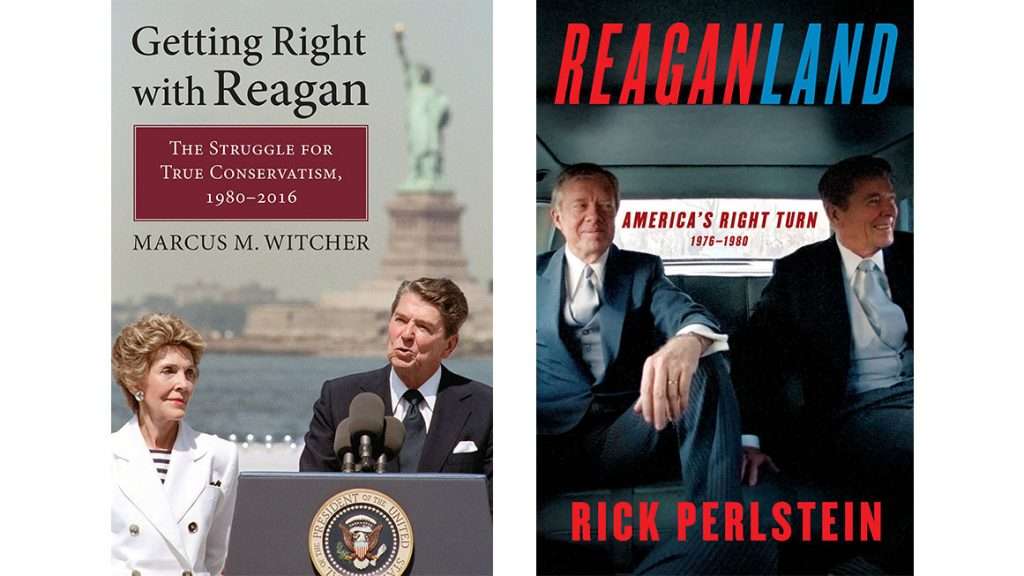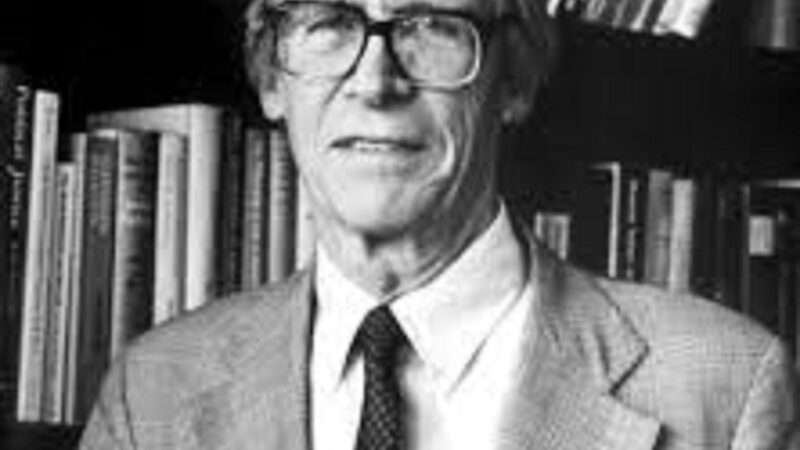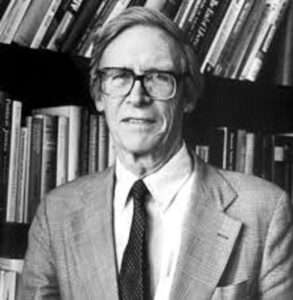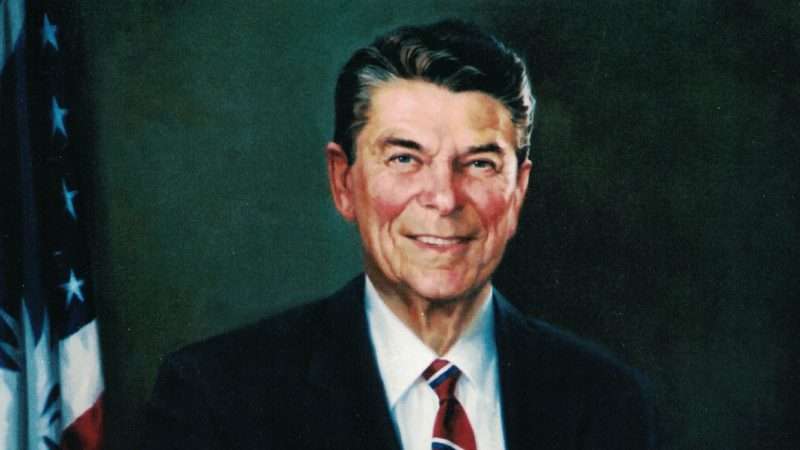How broad was the California tax revolt of the 1970s? Broad enough to stretch from Ronald Reagan to the Black Panthers.
The Panthers’ position is mentioned only briefly in Rick Perlstein’s Reaganland—just a single sentence meant to get across how widespread dissatisfaction with the state’s property taxes had gotten. But if you start poking around at that spot, you’ll find a deep rabbit hole just waiting for you to explore it. With “most tax increases,” proclaimed the Panther slate in Oakland’s 1973 municipal elections, “the poor always suffer and Black people, in particular, suffer most.” The candidates went on to decry everything from the property tax to the business license tax, and along the way they complained about how much money was spent on police pensions and downtown businesses. They also grumbled that black Oaklanders were being taxed without representation, since the levies were imposed “by the all-white Oakland City Council.”
Reaganland is 914 pages long, not including its extensive endnotes, and nearly every one of those pages could send you down an equally fascinating rabbit hole. This is the fourth and probably final volume in Perlstein’s series of books on recent American history, and like its predecessors it is both informative and entertaining. Perlstein is an engaging storyteller with a talent for juggling multiple narratives, and he is able—not always, but usually—to write empathetically about people he fundamentally disagrees with, a useful skill for a liberal historian describing a country’s turn to the right.
That shift is Perlstein’s big subject, a fact he signals by subtitling the book America’s Right Turn, 1976–1980. The combination of title and subtitle might prompt a double take, since Reagan did not become president until 1981. For the bulk of Reaganland, the man in the White House is not Reagan but Jimmy Carter.
Yet the title isn’t an error. One of the book’s chief themes is that America’s move rightward began well before Ronald Reagan entered the Oval Office. Its cover shows Reagan and Carter seated together in the back of a limo—two rivals riding the same car. Their destination: Reagan’s inauguration.
* * *
A familiar metaphor—often attributed to Reagan, though its origins are cloudy—calls conservatism a three-legged stool. In its idealized form, the three legs are free enterprise, a strong national defense, and traditional moral values. In practice, “free enterprise” is often a cover for protecting or subsidizing business interests, “national defense” for global intervention, “moral values” for moral panic.
However you define them, each leg grew stronger as the ’70s melted into the ’80s. They gathered this strength not just within the organized right but outside it. These weren’t three legs of a stool so much as three sweeping trends that at times combined to form the conservative movement but were quite capable of operating independently too.
The social conservatives were concentrated in a network known as the New Right. The New Right’s boundaries are not easy to define, but three overlapping developments were at its core. One was a set of high-profile grassroots right-wing rebellions in the early ’70s, notably the anti-busing riots in Boston and a dispute over textbooks in West Virginia. Another was Christian conservatives’ growing willingness to enter the political realm—and to work across denominational lines—to battle secularism. (The most important causes here were the fights against legalized abortion and against an effort to strip segregated religious schools of their tax-exempt status.) The third element was a group of money-savvy activists, many of them based in the world of direct mail, who set out to weave those organic backlashes into an organized political force.
Perlstein is at his best covering these culture wars. The lead-up to the National Women’s Conference of 1977, a battleground between feminists and traditionalists, is rendered here as a series of vivid set pieces told from multiple points of view. Perlstein’s political sympathies are with the feminists, but he’s attuned to the reasons many working-class women felt alienated from the most visible feminist groups. “Feminist leaders tended to be lawyers, professors, and foundation executives. No wonder they viewed working outside the home as fulfilling,” he writes, summarizing a ’70s study. “The same survey found that most antifeminist activists who worked were unmarried, had menial, deadening jobs, and 90 percent had no college degree. In the world as these women experienced it, marriage was what rescued you from work.”
Perlstein is similarly sensitive when describing that conflict over tax exemptions for segregated schools. Most modern accounts see this as little more than a batch of racists trying to preserve their privileges, but Perlstein notes that the new rules really were poorly crafted: The institutions whose representatives descended on Washington to protest the change included not just segregation academies but schools that made good-faith efforts to recruit black students. They just couldn’t afford the procedural hurdles the rules would impose. After hearing many hours of testimony along these lines, the Internal Revenue Service revised the proposal to take some of these complaints into account.
That’s not to say the dispute was a mere misunderstanding, easily resolved. For many Christians, that compromise wasn’t enough; there were deeper ideological battles, and not just the one over race. To the proposal’s most radical opponents, the key question was whether the government could dictate orders to religious institutions in the first place. “These men do not have the rightful authority,” one testified, “to tell us how to run our schools, our homes, and our churches.”
As the cultural revolutions of the 1960s and ’70s swept through the country, the backlash was not limited to the New Right; it wasn’t just Jerry Falwell’s fans who found themselves uncomfortable with widespread marijuana use or the new visibility of gay culture. And the second leg of the conservative stool was even more well-represented outside standard conservative circles. Liberal hawks had long been a part of the political landscape, and they coexisted uneasily with the Carter administration’s more dovish members. Carter himself grew more hawkish toward the end of his term. And if that wasn’t enough for antsy Cold War liberals, a new tribe was waiting to welcome them.
The neoconservatives—an assortment of formerly left-wing figures driven rightward, in part, by their Cold War commitments—were becoming a bigger presence in elite circles. Their favorite politician was Scoop Jackson, a senator from Washington who mixed his left-liberal economic opinions with militaristic views on foreign policy. But with Jackson unable to take the Democratic nomination and with Reagan hoisting the anti-détente banner in the GOP, many neocons were willing to cross party lines. They offered a highbrow counterpart to the lowbrow jingoism of the New Right, which stoked grassroots anger with direct-mail broadsides against the Panama Canal “giveaway.”
* * *
And then there’s the stool’s third leg—the one that’s either pro-market or just pro-business, depending on how seriously the speaker takes his small-government rhetoric.
I mentioned earlier that Perlstein usually writes with empathy about positions he doesn’t share. This is the area where he is most likely to let that slide. Take his discussion of Free to Choose, a 1980 TV series hosted by the libertarian economist Milton Friedman: Here the text sometimes devolves into heckling, as when Perlstein complains that the show’s praise for Hong Kong’s free market successes was a “thoroughgoing fantasy” because it did not mention that the city government constructed housing and subsidized the harbor ferry on which Friedman was filmed praising Hong Kong’s market economy. But Friedman was making an argument about the absence of trade barriers and economic controls, not claiming that the city had no economic interventions at all. (The book version of Free to Choose, which has more space for details, does mention both the public housing and the transportation subsidies.)
Perlstein is better when discussing the group he calls the “boardroom Jacobins.” Before the ’70s, he notes, business interests tended to accommodate themselves to federal regulation. Or at least a certain sort of company did: “blue-chip firms, safe, stable, and perennially profitable, impervious to economic downturns.” Resistance was more likely to come from businesses that were “smaller, family-held, concentrated in midsized cities that ordinary citizens rarely dealt with, who didn’t care what the New York Times said about them.” These enterprises “tended to operate with less secure profit margins compared to blue-chip firms, and felt far more vulnerable to federal regulation.” And they didn’t have nearly as much pull in Washington.
But in the ’60s and ’70s, an anti-business backlash fueled a new wave of restrictive legislation, much of it pushed by the crusading attorney-activist Ralph Nader. Larger businesses eager to fend off those rules became more willing to criticize the post–New Deal state. They also became more willing to call on voices around the country—sometimes real grassroots activists, sometimes astroturf fronts—to argue their case. And so Perlstein’s Jacobin capitalists were born.
As always, many politicians of the era used free market rhetoric as a cover while advancing economic interventions on corporate interests’ behalf. In the Republicans’ 1980 presidential primaries, the most pro-business candidate was former Texas Gov. John Connally. Connally was happy to invoke the idea of free enterprise, especially when it came to removing the regulations that afflicted his beloved energy companies, but his platform was filled with not-so-free market ideas about bailouts and subsidies—especially for those aforementioned energy companies.
Perlstein regularly highlights moments when Democrats, at times including Carter, were less willing to tax, spend, and regulate in this period. He is especially attentive to the ways this strained the president’s relationship with the more conventionally liberal elements of the party—tensions that culminated in Ted Kennedy’s challenge to Carter in the 1980 Democratic primaries. Perlstein arguably overstates Carter’s fiscal conservatism: The book notes several examples of the president’s reluctance to spend money, but total federal spending was nonetheless higher when he left office than when he came in. But if anything, Perlstein understates how much this rebellion against the liberal state took hold on the left.
Take the deregulation of trucking and air travel. These are market-friendly policies that were not mere sops to business, since they removed the rules that maintained the country’s transportation cartels. More to the point, they weren’t simply signed by President Carter; they were advanced in the Senate by Ted Kennedy, the very man who ran against Carter from the left. Outside the government, they were championed by the boardroom Jacobins’ bête noire, Ralph Nader. Indeed, Nader accused Reagan, Connally, and the U.S. Chamber of Commerce of being weak on trucking deregulation.
Nader was, in fact, a leading voice for loosening large swaths of the regulatory state. In his foreword to the 1973 book The Monopoly Makers, Nader decried “corporate socialism,” a system in which “public agencies control much of the private economy on behalf of a designated corporate clientele,” locking out competition, raising prices, and blocking disruptive technologies. Reaganland includes a detailed account of Nader’s failed attempt to create a federal agency of consumer affairs, an entity he hoped would be less susceptible to industry capture. It has less to say about his efforts to reduce the powers of those captured agencies.
Needless to say, Kennedy and Nader were not opposed to the entire regulatory apparatus. In The Monopoly Makers, for example, Nader took care to distinguish economic regulation, which he frequently opposed, from health and safety regulation, “which seeks to complement, not replace, a market system.” But then, many of those boardroom Jacobins defended economic interventions when it suited them too. (The Carter-era Chamber of Commerce supported several subsidies, and it fought to kill a bill that would have loosened federal restrictions on peaceful union picketing.) Anyway, my point isn’t that the liberal lions of the ’70s were really libertarians. It’s that the third leg of the conservative stool, like those other two legs, was hewn from sentiments that didn’t just show up on the right.
In 1980, the socialist weekly In These Times noted that “all three major candidates for chief executive of the world’s biggest government are running against big government.” The unsigned editorial did not proceed to defend big government. It argued that those candidates—Reagan, Carter, and independent John Anderson—didn’t really want “to end federal government involvement in the economy,” since “federal regulation of the economy has been welcomed or sought by American business leaders since the late 19th century” and most federal regulation “has been a case of big business regulating itself and others through government.”
Echoing Nader, the editorial went on to distinguish those unwelcome rules from legislation “in the spheres of safety, health and the environment,” which it supported. But it wrapped up by demanding a “socialist federalism that will strengthen the power of state and local governments and begin dismantling the highly centralized agencies created to insulate corporate power from popular control.”
States’ rights and an assault on the regulatory state, but from the left. Is this mirror-universe Reaganism?
The authors of that editorial were not free marketeers, no more than John Connally was. But they were deeply disillusioned with the mid-century liberal consensus. The sheer ubiquity of this disillusionment suggests that more was afoot here than a mere right turn.
* * *
That rejection of the consensus had its limits. Most American voters did not relish the thought of, say, giving up their Social Security checks. Periodically in Reaganland, the title character claims while campaigning that he had never said Social Security should be voluntary. Perlstein points out that the younger Reagan had, at the very least, called for adding “voluntary features” to it.
Once in office, though, Reagan stuck with his revised position. In 1983, facing the possibility that Social Security would become insolvent, he raised the payroll tax and forced a host of federal employees to start paying into the system. The bill that did this, he declared, “demonstrates for all time our nation’s ironclad commitment to Social Security.”
That legislation is discussed in another recent book, Marcus Witcher’s thoughtful Getting Right With Reagan. If Reaganland reminds us that America’s right turn began well before Reagan became president, Getting Right With Reagan reminds us that it didn’t go nearly as far as the conservatives of the 1980s preferred. Witcher, a historian at Huntingdon College, examines all three legs of the right-wing stool, showing how economic, social, and defense conservatives each found disappointment in the Reagan years.
For angry free marketeers, Reagan was a president who promised to keep spending under control but instead let it explode, who promised free trade but imposed new tariffs and quotas, who never deregulated as much as Carter did and in some spheres regulated more. For disgruntled social conservatives, Reagan was a fair-weather friend who chased their votes but rarely expended any political capital on their behalf. The hawks were particularly prone to cursing the president after he moved toward negotiations with Soviet leader Mikhail Gorbachev.
Witcher’s argument isn’t that Reagan wasn’t really a conservative; it’s that he wasn’t as uncompromising as his base would have liked. (If you’re used to hearing AIDS activists arguing that Reagan barely lifted a finger to stop the disease, your head may spin as you read quotes from New Right activists unhappy that he barely lifted a finger to crack down on gays in the name of public health.) Witcher makes a good case that the 40th president didn’t prioritize the social conservatives’ issues, though he doesn’t discuss some places where Reagan did give them some wins. It was Reagan’s attorney general, after all, whose pornography commission called for a crackdown on obscenity. And the Federal Communications Commission tightened its restrictions on “indecent” radio broadcasts during Reagan’s presidency, though the so-cons surely considered that a bittersweet victory as not just profanity but nudity became standard fare on cable television.
In short, Reagan threw social conservatives some bones but didn’t really try to stop the broad cultural shifts that their movement was dedicated to reversing. Tellingly, the administration’s most notable socially conservative policy was one that drew support from across the political spectrum, not just from the New Right faithful: the war on drugs. A broad-based moral panic got political results that a self-consciously conservative band of lobbyists and ideologues could not.
The other place where Witcher doesn’t grapple as thoroughly as he could with Reagan’s record is the so-called Reagan Doctrine, a policy of arming anti-communist forces in the Third World. Witcher mentions the most prominent of those rebel groups, the Nicaraguan Contras, noting that several conservatives complained that the White House wasn’t as committed to the Contra cause as they were. Fair enough, but Reagan did keep the aid flowing. More importantly, the president’s willingness to intervene in Third World conflicts, from Nicaragua to Angola to Cambodia, reveals a record more hawkish than you see if you focus solely on his relations with the Soviet Union.
Even the Reagan Doctrine had roots—or at least one root—in the Carter era. One of the anti-communist groups receiving U.S. assistance was the mujahedeen, a Muslim guerrilla force fighting Soviet invaders in Afghanistan. That particular flow of aid began under Reagan’s predecessor. Once again, a leg of the conservative stool looks a lot like forces that aren’t ordinarily thought of as conservative.
* * *
The picture becomes yet more complicated when you compare the U.S. with the rest of the world. Virtually every country has adopted at least some degree of market reform since the late 1970s—and how much they liberalized doesn’t seem to be correlated with how attached they are to moral conservatism or to international saber-rattling.
Who enacted the most radical market reforms of the late Cold War? The nominally socialist New Zealand Labour Party, which freed prices, deregulated industries, privatized state-owned enterprises, and eliminated an assortment of subsidies. It also decriminalized gay sex and barred nuclear-armed American ships from its ports.
When the conservative stool’s three legs are separated, the result is not rubble; it’s a host of alternative stools, fashioned from alternative combinations of legs. Libertarians preach open markets without supporting vice laws or the national security state. Certain sorts of authoritarians do the reverse. And every now and then, there’s a Panther tax revolt.

Reaganland: America’s Right Turn, 1976–1980, by Rick Perlstein, Simon & Schuster, 1,120 pages, $40
Getting Right With Reagan: The Struggle for True Conservatism, 1980–2016, by Marcus M. Witcher, University Press of Kansas, 448 pages, $39.95

from Latest – Reason.com https://ift.tt/2ZAWhOB
via IFTTT




